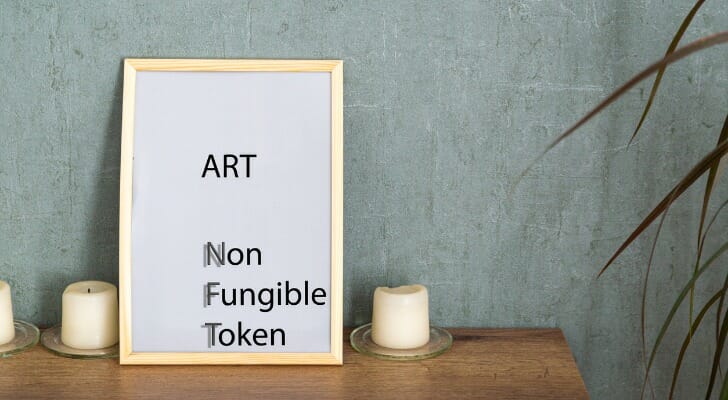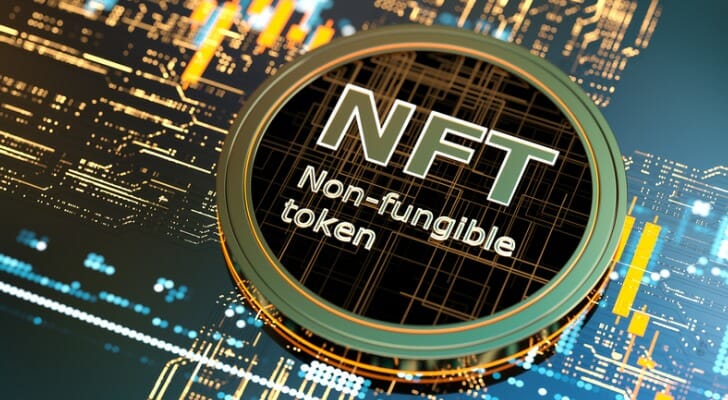When a new investment trend emerges, you may wonder what all the fuss is about. It’s happened several times with each new variation of cryptocurrency, and NFTs are set to be the next big thing among investors who are interested in adding more than just stocks and bonds to their portfolios. But what exactly is an NFT and is it something you should be investing in? Here’s more on how this alternative investment works. Consider working with a financial advisor on picking alternative securities.
NFT, Explained
NFT stands for non-fungible token and it’s a term that’s used to refer to digital assets. Specifically, that means digital assets that can be traded using blockchain technology, similar to the way Bitcoin and other cryptocurrencies function.
The term “non-fungible” is significant, because it denotes assets that have no trading equivalent. In other words, NFTs are one of a kind. That’s what distinguishes them from other cryptocurrencies. Some of the most notable examples of NFTs that have recently sold for millions include Jack Dorsey’s first tweet and a digital art collage of images from artist Beeple.
How NFTs Work
A non-fungible token or NFT is a piece of digital content that’s linked to the blockchain. If you’re not familiar with how blockchain works, it’s essentially a digital database and it’s what makes the mining of Bitcoin and trading of other cryptocurrencies possible.
An NFT can be used to represent a variety of different assets, including:
- Artwork
- Music and audio files
- Collectibles such as trading cards
- Virtual items, including in-game items or currencies
- Virtual land
- Video footage
- Real-world assets that have been tokenized
Creating an NFT starts with a blockchain service. Ethereum is commonly used but there are other blockchain services that issue NFTs as well. One thing to know is that your choice of blockchain determines where a non-fungible token can be traded. If you create an NFT on Blockchain A, for example, you wouldn’t be able to trade it through a marketplace supported by Blockchain B.
Beyond that, all you really need to create an NFT is a digital wallet, digital currency for the blockchain service you plan to use and the asset itself. So if you were planning to create an NFT of a trading card using Ethereum, for example, you’d need a digital wallet that supports Ethereum blockchain and the corresponding cryptocurrency, which in this case is called ether.
Compared to mining bitcoins, creating an NFT is a much simpler process and it’s something virtually anyone with a basic understanding of blockchain can do. Once you’ve created an NFT, you can either hang on to it or you can sell it. You can do this through the same marketplace where you created it.
In terms of what makes some NFTs worth more than others, it typically comes down to scarcity or rarity. Using the previous example, there can only be one first tweet from Jack Dorsey which increases its rarity and in turn, its sale price. The same is true for the Beeple collage, which sold for $69 million at auction. So how much you can sell an NFT for largely depends on how rare it is and what the demand for it is like from would-be buyers.
How to Buy an NFT

If you’re interested in buying NFTs, you’ll first need to locate a blockchain marketplace that sells them. Again, you’ll need to have the appropriate cryptocurrency for that marketplace to complete the purchase. That may require opening an account with a particular marketplace if you don’t already have one. One thing to note about buying NFTs is that they may not be on sale all the time. In the case of non-fungible tokens for digital artwork, for example, those may only be released at certain times.
So before you can purchase a particular type of NFT, you may need to spend some time in the marketplace to get a feel for how it operates.
Whether you’re buying or selling, it’s important to choose a reputable marketplace. And it’s also important to consider what you might pay in fees. Some NFT marketplaces may charge a fee for simply using the platform to complete a sale or purchase while others may charge conversion fees for converting your dollars to cryptocurrency.
Are NFTs a Good Investment?
NFTs represent a developing investment trend that appears to have staying power, at least for the short term. The upside potential can be huge for investors who are able to create NFTs and sell them at high prices or those who are able to buy NFTs for a bargain, then flip them for profit. But like any other trendy investment NFTs do have some risks to be aware of.
First, cryptocurrency and its relatives, including NFTs, can attract more volatility than something like stocks or real estate. So investing in NFTs tends to carry a higher degree of risk than other more traditional investments. If you’re generally more risk-averse, the potential to net higher returns may not be enough to lure you into NFTs as an investment tool.
Next, there’s liquidity risk. If you have an NFT that’s in-demand then it may be relatively easy to find a buyer for it and convert your digital assets to cash. But if not, you may be stuck with an investment that’s doing very little for you while keeping your cash tied up. So if you’re interested in NFTs, it’s good to consider how much of your portfolio you want to allocate to them.
Something else to keep in mind is the potential for fraud. Cryptocurrency is largely unregulated and there’s plenty of room for fake NFTs to flood the market. It’s quite easy for an inexperienced investor to fall for a scam if they aren’t able to distinguish what’s fraudulent from what’s not. And even advanced investors may not recognize an NFT scam if it’s extremely sophisticated. The end result is that you could lose money.
Bottom Line

NFTs represent a new type of digital investment asset that you may consider as an alternative to owning tangible assets, such as artwork or collectibles. Before you dive in, it’s important to gauge the risks against the rewards to determine if it’s right for you. It’s a newer phenomenon so it hasn’t been tested by time yet. While there’s certainly room for growth, it’s possible that NFTs could experience the same growing pains as other new investment trends, including corrections or even a crash. So keep those things in mind as you decide whether to invest.
Tips for Investing
- If you’re interested in blockchain investments but aren’t quite ready to trade NFTs or cryptocurrency directly, there’s another option. There are a handful of blockchain exchange-traded funds (ETFs) that offer exposure to this emerging technology. Investing in ETFs allows you to own a basket of investments inside a taxable brokerage account and diversify your portfolio without having to join a blockchain marketplace. If you don’t have an online brokerage account yet, consider looking for one that offers commission-free trades for stocks and ETFs.
- Consider talking to a financial advisor about whether NFTs are something you should be adding to your portfolio. SmartAsset’s free tool makes it easy to connect with professional advisors in your local area. It takes just a few minutes to get your personalized advisor recommendations online. If you’re ready, get started now.
Photo credit: ©iStock.com/zimmytws, ©iStock.com/Natalia Shabasheva, ©iStock.com/Vertigo3d
